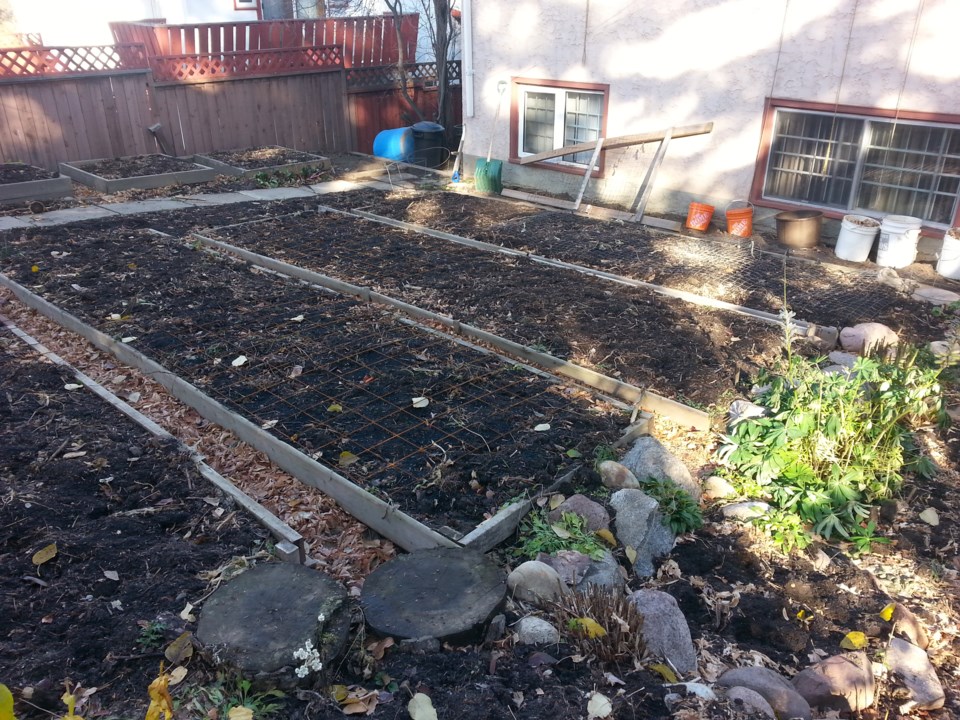The average home garden should have at least 20 inches of fertile soil. While the roots of many vegetables are shorter than 12 inches, the rootlets may go down 8 feet or more into the subsoil. The deeper the fertile soil, the more productive your garden will be. The yield of vegetables in 20 to 24 inches of fertile, aerated soil, can be at least double that of a conventional 8-inch garden depth.
To create the best soil, start with double digging, a onetime process. This involves digging a trench, first laying the soil to one side, then digging the trench another shovel depth deeper, placing the second layer to the other side. Then place the first layer on the bottom of the trench, and the second layer on top. This creates a much deeper layer of soil for the roots to grow in. Continue and as you fill each trench, add layers of compost, mixing it into the soil. Every year, try to add two inches of compost, incorporated into the top six inches of the soil.
Plants need nutrients, water, and air. A soil with lots of compost holds moisture, has pores of oxygen, and generally has all the nutrients needed for healthy plant growth. Without these three components, plants may become stressed and unhealthy. There is general agreement that healthy plants are more able to resist insect pests and plant diseases.
Most vegetables grow best in a soil with a pH of just under 7. However, blueberry bushes, rhubarb, and potatoes like a somewhat acidic soil with a pH around 5. Check the pH of your soil with a pH metre. Or have a soils lab test it.
Gardening with raised beds is a major time saver. Thinning and weeding can be done at any time, wet or dry. Crop rotation is easy to plan. You won’t compact the soil by walking on the planting area.
Raised beds are simple to make. I prefer two 2”x 8” untreated boards for each of the four sides. Fasten the ends to the sides with 3 ½ inch wood screws. Then fasten 2” x 2” pegs to each corner. This will give you 15 inches of soil, plus the soil under the raised bed. The internet describes other types of raised beds.
Make the raised bed 4 feet wide; length is optional. A four-foot width is ideal to plant, weed, thin, and harvest from either side. Separate each raised bed with a minimum 16-inch path.
Composting vegetable leaves and stalks from your garden will recycle trace minerals that were removed from the soil by those same vegetables and therefore will maintain your soil fertility.
A simple way to make compost Is to have two bins about 6x4 feet long and wide, and 3 feet high. Start in the summer and fill the first bin with grass clippings, leaves and stalks, shredded paper, and kitchen scraps. In the beginning of the next July, turn the semi decomposed material over into the second bin, and start to fill the first bin. In the fall place the composted material from the second bin onto your garden.
Do not compost animal excrement, meat and fish, dairy products, diseased plants, coal or charcoal ash, glossy paper, treated or painted wood, diapers, coated cardboard or plant material that has been sprayed with pesticides or herbicides.
The soil is filled with beneficial bacteria, fungi, worms, and other critters that help your vegetables grow more productively. Roto tilling or digging with a shovel disturbs or kills many of these organisms. Loosening the soil with a broad fork reduces the harm to these organisms.
Finally, practice crop rotation, never planting the same vegetable in the same location for at least three years. This reduces the depletion of trace elements and fools pests that tend to return to where they were born.
Follow these steps and your garden will flourish.
Charles Schroder gardens in the Edmonton area.



